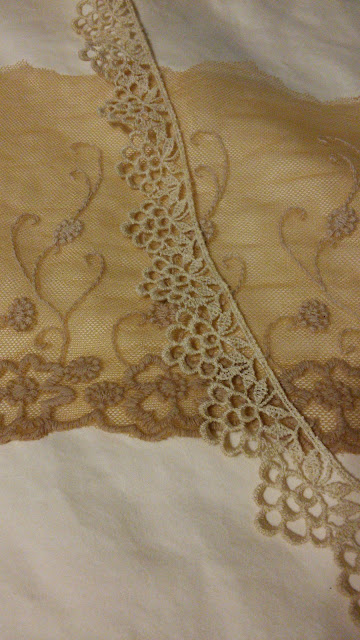So, what's a historical seamstress to do? Abandon lace all together? Absolutely not! (Well, you could, but that would be no fun.) Mostly, one must just make do with modern laces that don't scream "I'm Synthetic!", but whisper it instead. Or, there's the second option, and my favorite, use vintage lace (if it can be found at a reasonable price) Typically, I wind up mixing these two options.
I have a reasonable collection of vintage lace trim, a lot of it polyester from the 70's, but also some older stuff that's made out of cotton. This is always the first place I go to look for lace for my historical dresses, and my mom's red 1890's aesthetic gown I'm currently working on was no exception.
A search through my lace produced this 1" wide ecru colored cotton lace. It somewhat resembles lace from the late 19th century and the color is perfect with the red linen we bought for the dress! This would trim the neckline, now I just needed some wide lace for the sleeves. After lots more time spent going through my stash, I concluded I had nothing that was quite right for that. All that was left to do was to go to the store.
At Hobby Lobby I found this embroidered net lace. It could work on a historical dress! I loved the style of it next to the lace I'd picked out for the neckline, there was just one issue, the color. I wanted both laces to be the same color. Thankfully, with a little bit of tea, I figured that wouldn't be too hard to achieve.
The lace was a mixture of cotton (the embroidery) and polyester (the netting). I was sure the cotton would take the tea dye nicely, but I thought the polyester might come out of the tea the same color it was when it went in. I was ok with this possibility. I put my lace in a saucepan of strong tea on the stove and left it there for about 1/2 an hour. As I was slowly feeding the lace into the tea I accedently let in touch the edge of the pan and the polyester netting started to melt. Oops! Hopefully I would still have enough undamaged lace to trim both sleeves!
After 30 minutes out of the tea the lace came, and I rinsed it off with cold water. So far it looked like the polyester had taken the dye! Now I just needed to wait for the lace to dry so that I could see what the final color would be, but I was too impatient to wait for it to air day. (I was ready to sew the lace on the sleeves!) So I pulled out the hair dryer (which somehow I never take time use on my hair) and had that lace dried as soon as possible!
I found the one place I'd accidentally let the lace touch the edge of the hot saucepan when I was putting the lace into the tea. Yikes! Polyester melts really well! Thankfully, it looked like I still had enough undamaged lace to trim both sleeves. The color was looking pretty good too! Next came the real test, how did it compare to the other lace? Well. . .
It's not an exact match, but since the laces won't be directly next to each other on the dress, it will work!
I sewed the lace onto the sleeves (I had just enough despite the melted hole!), and I must say I love how the tea dyed net lace looks with the red linen!
I finished the sleeves that weekend and now both laces are on the dress and the outer layer of fabric just needs to be gathered up and attached to the lining. The end of making this dress is in sight! Here's hoping my mixture of old cotton lace and new tea-dyed lace is the perfect finishing touch for the overall effect of this gown!
So far I'm liking what I see! Just 3 more days and this lacey red 1890's aesthetic dress should be done!










No comments:
Post a Comment